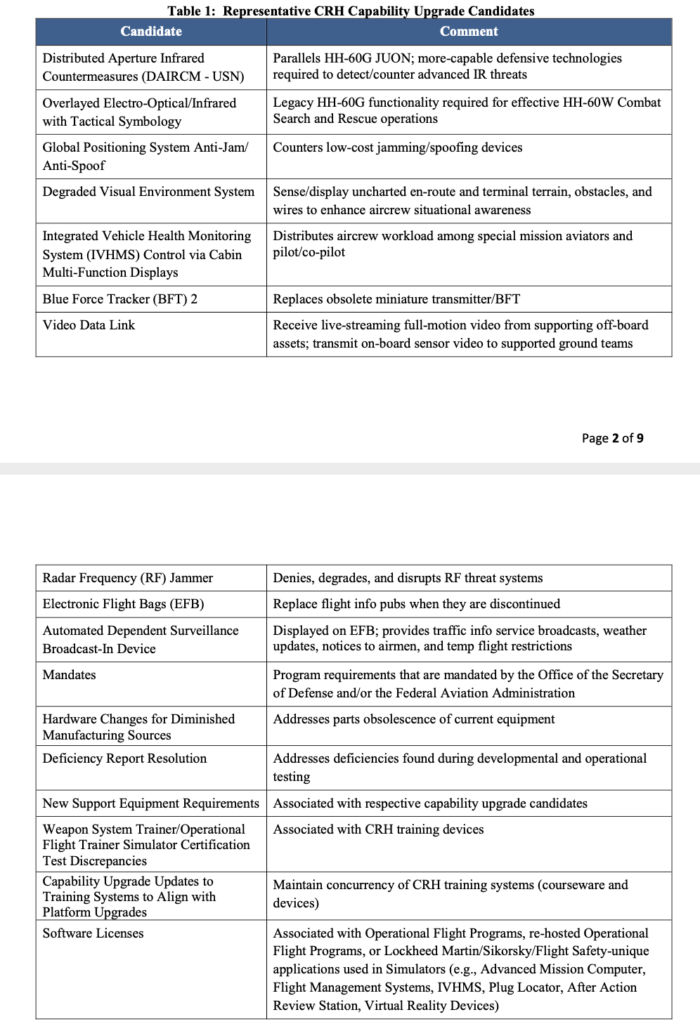Enemy threats are outpacing development of the U.S. Air Force’s new Combat Rescue Helicopter (CRH), prompting the Air Force to offer Sikorsky nearly $1 billion for capability upgrades to the HH-60W just as it enters service.
“The government has a requirement for a new contract vehicle to address a broad spectrum of known and undefined CRH operational capabilities,” according to a justification document posted Feb. 11 on the U.S. government’s contracting website.

Under the potential five-year deal for rolling capability upgrades to both the helicopter’s hardware and software systems, Sikorsky — owned by Lockheed Martin — stands to receive up to $980 million.
The Air Force already has taken delivery of two HH-60W helicopters. Sikorsky holds contracts worth $1.6 billion for the first 22 of a planned fleet of 113 HH-60Ws that will replace its aging and battle-worn HH-60G Pave Hawks.
The new helicopter was dubbed the Jolly Green II after the legendary HH-3E “Jolly Green Giant” combat search-and-rescue helicopter famous for plucking downed pilots from lush Vietnam War jungles.
Requirements for the Combat Rescue Helicopter were finalized and frozen in 2012 before Sikorsky was awarded the contract for building helicopters for the engineering and manufacturing development (EMD) phase of the program. Those helicopters passed a “critical design review” and a decision to begin low-rate initial production was made in September 2019. The Air Force will decide whether to enter full-rate production in “early fiscal year 22,” which begins Oct. 1.
“During the last five years of EMD execution, the original CRH requirements baseline has evolved as a result of changes in threat conditions and evolving mission requirements,” the contract award document says. “The response to this operational need is the driver for the continuance of new capability development and integration into the CRH baseline and subsequent fielding to each main operating base.”
Future capability upgrades will be based on “user approved, prioritized and funded requirements,” gleaned from multiple operational needs statements the Air Force has in hand and “must commence” in the current fiscal year. Specific shortlisted upgrades and the number in hand are redacted form the report, but both hardware and software upgrades are needed, the Air Force said.
Upgrades will cover, but are not limited to avionics (both hardware and software), structures, mandates, deficiency reports, diminishing manufacturing sources and training systems, and will be completed over five years.
Though the contract award to Sikorsky blacks out the candidate capability upgrades, 17 new requirements are listed in a “sources sought solicitation” published in October 2019.

The Air Force already is buying some of the candidate upgrades for integration into the legacy HH-60G “in order to combat real-world threats which demonstrates the immediate need for incorporation into the CRH,” the Air Force said.
As builder of the baseline H-60 helicopter and having developed the HH-60W from the UH-60M Black Hawk, Sikorsky is the only company capable of delivering Air Force requirements with the CRH as currently configured, the service said in its justification for not opening the program to competing manufacturers.
“Sikorsky is the only responsible source for this follow-on contract for the continued development and production of a major system because award to any other source would result in unacceptable delays in fulfilling the government’s requirements,” the Air Force said.
“Delays in capability fielding, attributable to contracting or funding issues, could translate to degraded operational mission effectiveness and suitability — to the detriment and survivability of joint and coalition personnel. Initiating the vital CU requirements will close recognized capability gaps between the HH-60G and the replacement HH-60W helicopter.”
Under the structure of a so-called indefinite-delivery, indefinite-quantity (IDIQ) contract, the government can compete future capability upgrade deliveries. At least a few companies other than Sikorsky are interested in working on upgrades for the HH-60W, but their names are redacted form the contract award. The Air Force acknowledges that “multiple industry sources will be capable of meeting certain CRH capability upgrade requirements if they have access to a full technical data package (TDP), which is delivered to the government as part of the deal with Sikorsky.









